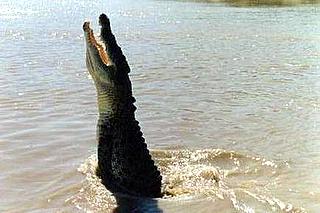We had just finished a fantastic evening barbecue at
our Kakadu hostel. Most of us were settling in for an evening of
drinking, talking and fighting off insects around the camp fire.
“Come on everyone, let’s go croc spotting”
the hostel host said enthusiastically.
“Croc spotting?” someone exclaimed
“but it’s night time?”
“Well, you don’t have to if you don’t want
to” he said somewhat disheartened before adding. “I
just thought you’d like to! Kakadu is another world at night!”
He paused to think of what else he could say to sway
those hesitant.
“You don’t know when you will be
back? But I’ll leave it up to you. I will be leaving in 10
minutes which will give you enough time to grab a jumper, a torch and
put on a pair of walking shoes. Therefore, if you decide to come, you
can meet me at the hostel gate”.
I already knew that I wanted to go night croc spotting.
After all, I didn’t come all this way to miss out on
anything. Off we headed into the darkness, a mini bus-load of city
dwellers led by a bearded, bare-footed reptile lover along a moon lit
dirt track in search of salt-water crocodiles. After a 15 minute walk
which involved brief stops to look at the local flora and fauna
including a spider which could have easily slapped someone with one of
its huge legs, we arrived at a causeway.
“This is close enough I think” said
our host. The causeway can be crossed by foot during the dry season,
but as we weren’t quite in this season yet the causeway still
had water rushing over it. Apparently it was a great fishing area.
Unfortunately, we were told that only the week before a young boy was
taken by a crocodile while fishing with his father here.
Our host spotlighted the causeway with his torch. We
were about 50 feet away from it. A long, rough, grey croc tail
disappeared over some rocks. This brought gasps of ‘wow’. It truly was
an incredible sight to see a crocodile in its natural habitat. He then
scanned the river with his torch.
“Look” he said excitedly “see those
two orange snake eyes?”
I squinted into the darkness until I saw those two
orange spots.
“Well that’s a croc” he said
“and a bloody big one too”.
“How can you tell?” someone asked.
“The larger the eyes the bigger the croc.
I’d say that one is at least 6 foot long, even
more”.
“Wow” someone said. Wow seemed to
be the word of the evening as most of us stumbled for words describe
what we were seeing.
The area turned out to be mission control for our
crocodile spotting. We all took turns standing next to our host looking
at those illuminated, transparent, marble-like eyes. They were
hypnotising. I felt like a kangaroo staring into some headlights.
 More
pairs of orange marbles appeared hovering in the darkness ahead of us.
There must have been at least a dozen. No doubt, the buggers were
thinking, food, succulent live food of all shapes and sizes, all
waiting for an underwater roll. I was glad they were all over there and
we were here.
More
pairs of orange marbles appeared hovering in the darkness ahead of us.
There must have been at least a dozen. No doubt, the buggers were
thinking, food, succulent live food of all shapes and sizes, all
waiting for an underwater roll. I was glad they were all over there and
we were here.
“Have you ever smelt croc before?” our host
suddenly asked.
“No” someone said, and I thought, I don’t
think I want to.
“Can you smell that briny, salty water smell?”
I stuck my nose out into the darkness and let the smell
fill my nostrils. It was an odour I was familiar with. It was similar
to the smell of drying seaweed on a beach. Yeah I can smell that briny,
salty water smell which intensified the longer I smelt it. No cause for
alarm though I thought, after all, we have kept our distance.
“RUN” our host yelled.
It took a few seconds for what our host just said to
register, but when it did, I and everyone else joined our host high
tailing it back up the track. Whether this was a joke or not I am not
sure. However, if you take a trip into Kakadu and your host of the
hostel asks you to come for a walk to do some night croc spotting make
sure you stay behind him at all times.

 More
pairs of orange marbles appeared hovering in the darkness ahead of us.
There must have been at least a dozen. No doubt, the buggers were
thinking, food, succulent live food of all shapes and sizes, all
waiting for an underwater roll. I was glad they were all over there and
we were here.
More
pairs of orange marbles appeared hovering in the darkness ahead of us.
There must have been at least a dozen. No doubt, the buggers were
thinking, food, succulent live food of all shapes and sizes, all
waiting for an underwater roll. I was glad they were all over there and
we were here.